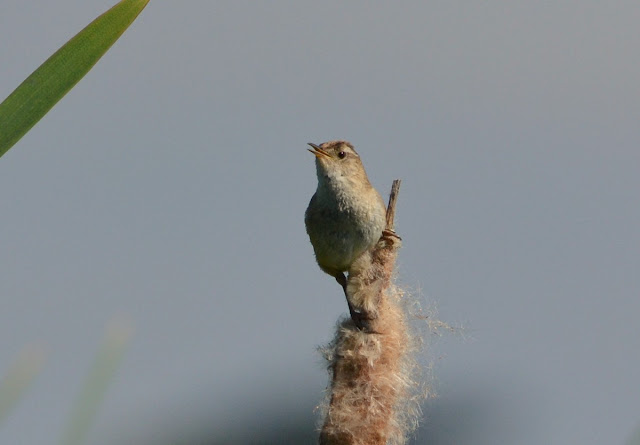I've started exploring the Arcata Marsh and Wildlife Sanctuary over the past couple of days. Just a few minutes drive from my house, this place is a nice combination of fresh and saltwater marshes, grasslands, and bay. And it doubles as a wastewater treatment facility for the town, which is pretty cool (and not something I ever would have realized if it wasn't publicized).
Apparently the Arcata Marsh is a very popular spot for birdwatching (judging by its thousands of eBird checklists), and I certainly saw a lot of birds when I walked along some of its marshes and grasslands yesterday afternoon. There was so much activity! The air above the marshes was filled with swooping swallows and swifts -- I'm still figuring out how to identify all the swallow species we have here! -- and birds were calling all over the place. Pretty much everywhere I went, I heard Marsh Wrens, although I didn't know that's what I was hearing until this individual jumped boldly out of the cattails (where all the other birds were apparently hiding) and sang:
(You can hear a Song Sparrow singing in part of that video as well. I love Song Sparrows and I'm so glad to find them here.)
I saw a Marsh Wren only once while I lived in Connecticut, and that was a very brief glimpse through some dense reeds. The Arcata Marsh, by contrast, is practically overflowing with these small boisterous birds:
Sing it, Marsh Wren!
What a lovely little creature:
This wren made a few trips in and out of the cattails, and I eventually saw its nest, woven so neatly into the leaves at the marsh's edge:
Although much smaller in number -- at only four individuals -- the marsh's Common Ravens were certainly rivaling the Marsh Wrens for noisiness. This raven called from a tree near the path for several minutes, with other ravens nearby occasionally adding their voices; I love these birds' shaggy throats and their croaking calls, and I'm still getting used to the idea of ravens as "common" birds:
Most of the other creatures I met at the marsh were much less noisy, though still very active. Here's my first close encounter with a local hummingbird, a female, although I'm not sure whether she's an Allen's Hummingbird or a Rufous Hummingbird (I can't believe I live in a place with more than one hummingbird species):
Well, she's gorgeous, whatever she is:
I was happy to see so many familiar (to me) birds at the marsh as well. Male American Goldfinches are just as flashy out here in the west as they are in the east:
Hello, Black-capped Chickadee (post-bath):
A fly-by from a handsome Great Egret is always welcome:
I'm not sure what to make of these two Cedar Waxwings' behavior:
One waxwing was begging for food, and the other waxwing was feeding it, but it's awful early in the season for fledgelings (I think), and these birds both have the sleek filled-out costumes of adults. Perhaps this behavior falls under the umbrella of courtship? Or maybe this is a second-year bird falling back into old behaviors? Do either of those things even happen? In any case, there was certainly an exchange of food, which I'm sure made the begging waxwing very happy:
With bonus saliva:
There were other creatures besides birds out and about, of course. This Western Tiger Swallowtail was absolutely gorgeous; I don't know that I've ever seen such a pristine wild butterfly:
I also met my first Californian reptile! (I actually met this creature in another part of the marsh the previous afternoon.) This is one of the multiple types of Garter Snakes in the area, showing beautiful red markings; I haven't been able to quite narrow it down to species, but it's certainly a lovely creature:
I'm sure there are many, many more things still to discover in the Arcata Marsh. (I keep reading that there are River Otters there.... Otters!) I'm looking forward to exploring this place further in the months to come!















Glad you've got places nearby to go discovering. Great pictures!
ReplyDeleteHow lucky to be in such a rich ecological area!
ReplyDelete